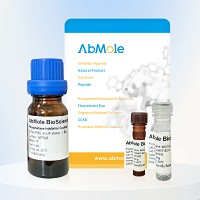All AbMole products are for research use only, cannot be used for human consumption.

Interleukin-21 (IL-21) is a approximately 14kda cytokine belonging to the IL-15/IL-21 family. IL-21 is produced by activated T follicular helper cells (Tfh), Th17 cells, and NKT cells. It plays its biological role through the heterodimer receptor complex (IL-21 specific il-21r). IL-21 is a cytokine that has a powerful regulatory effect on the cells of the immune system, including natural killer cells (NK) and cytotoxic T cells that can destroy viral infections or cancer cells. This cytokine induces cell division/proliferation in target cells. It is required for the migration of dendritic cells to draining lymph nodes, and it jointly stimulates the activation, proliferation and survival of CD8+ T cells and NKT cells, and promotes the polarization of Th17 cells. It blocks the production of regulatory T cells and its inhibitory effect on CD4+ T cells.
Accession: Q9ES17
APMol Mass: 16 KDa, reducing conditions
Endotoxin < 1 EU/µg
Lyophilized from a 0.2 μm filtered solution of 20mM Histidine-HCl, 6% Sucrose, 2% Glycine, 50mM NaCl, 0.05% Tween 80, pH 6.5.
| Form | Lyophilized powder |
| Solubility (25°C) | Dissolve the lyophilized protein in distilled water. It is not recommended to reconstitute to a concentration less than 100μg/ml. |
| Storage | Stored at ≤ -20°C, stable for one year after receipt. Reconstituted protein solution can be stored at 2-8°C for 2-7 days and at ≤ -20°C for 3 months. |
[1] Anusha Kalbasi, et al. Nature. Potentiating adoptive cell therapy using synthetic IL-9 receptors
| Related Cytokines and Growth Factors Products |
|---|
| Recombinant Human GDF-15 Protein (HEK293 N-hFc)
Growth-differentiation factor 15 (GDF15), also known as MIC-1, is a secreted member of the transforming growth factor (TGF)-β superfamily. GDF-15 has a role in regulating inflammatory and apoptotic pathways in injured tissues and during disease processes. GDF-15 overexpression arising from an expanded erythroid compartment contributes to iron overload in thalassemia syndromes by inhibiting hepcidin expression. |
| Recombinant Human FGFR1 Protein (HEK293, C-His)
FGFR1, also known as CD331, is a full-length representative protein consists of an extracellular region, composed of three immunoglobulin-like domains, a single hydrophobic membrane-spanning segment and a cytoplasmic tyrosine kinase domain. |
| Recombinant Human FGFR2 Protein (HEK293, C-His)
FGFR2, also known as CD332, acts as cell-surface receptor for fibroblast growth factors and plays an essential role in the regulation of cell proliferation, differentiation, migration and apoptosis, and in the regulation of embryonic development. FGFR2 plays an essential role in the regulation of osteoblast differentiation, proliferation and apoptosis, and is required for normal skeleton development. It also promotes cell proliferation in keratinocytes and imature osteoblasts, but promotes apoptosis in differentiated osteoblasts. |
| Recombinant Mouse BMP-4 Protein (E. coli, C-His)
Bone Morphogenetic Protein-4 (BMP-4) is a critical signaling molecule required for the early differentiation of the embryo and establishing of a dorsal-ventral axis. BMP-4 is secreted from the dorsal portion of the notochord, and it acts in concert with sonic hedgehog to establish a dorsal-ventral axis for the differentiation of later structures. |
| Recombinant Human Coagulation Factor X (HEK293, C-Fc)
Coagulation factor X, belongs to the peptidase S1 family. Coagulation factor X is initially synthesized in the liver. Coagulation factor X is a vitamin K-dependent glycoprotein that converts prothrombin to thrombin in the presence of factor Va, calcium and phospholipid during blood clotting. |
All AbMole products are for research use only, cannot be used for human consumption or veterinary use. We do not provide products or services to individuals. Please comply with the intended use and do not use AbMole products for any other purpose.


Products are for research use only. Not for human use. We do not sell to patients.
© Copyright 2010-2024 AbMole BioScience. All Rights Reserved.
